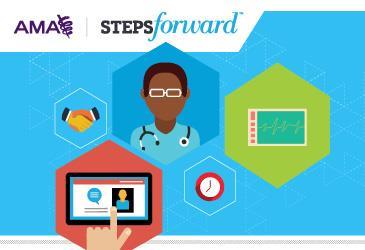While electronic health record (EHR) systems can be beneficial, the chief complaint with the technology for many physicians is that they’ve become typists and must spend time away from patient care for documentation. But some practices have found a solution to this problem by implementing team documentation—and they’re seeing returns on their investments. Learn how you can take this approach in your practice.
 Team documentation is a process in which staff assist with documenting visit notes, entering orders and referrals, and queuing up prescriptions in real-time while they are in the exam room with the physician and the patient. This frees the physician to focus on the patient.
Team documentation is a process in which staff assist with documenting visit notes, entering orders and referrals, and queuing up prescriptions in real-time while they are in the exam room with the physician and the patient. This frees the physician to focus on the patient.
For physicians implementing team documentation, it’s working. While many physicians are stuck spending hours in the evenings and on weekends with their EHRs, those who are using scribing aren’t.
“The only time I’ll ever even look at the computer is if I’m pulling up an X-ray or something,” said James Jerzak, MD, a family medicine physician from Wisconsin. “I never document at home. Everything is done and closed by the time I leave the office.”
Another Wisconsin physician, Richard Fossen, MD, said his internal medicine clinic has seen a return on investment since moving to team documentation.
“The revenue increases quite quickly once you get your model in place and your efficiencies run and you can open up slots in your schedule,” Dr. Fossen said. “You can see a return on your investment in a fairly short period of time.”
A free online module in the AMA’s STEPS Forward collection shows you how to implement team documentation in your practice. Visit the module to calculate what your practice could save and get an in-depth look at what team documentation looks like in practice. But first, read these eight steps to team documentation.
- Create a change team. You can’t make a big change in your practice without help. Select a high-level champion and a multi-disciplinary team that can agree on the goals, such as improved patient and clinician satisfaction and improved productivity.
- Decide who will help with team documentation. Will it be a medical assistant, a nurse, a pre-med student, a former transcriptionist or a dedicated scribe? The type of assistant will determine his or her scope of work.
- Determine the model your practice will use. Will the assistant only help with documentation or also perform clinical tasks? In a documentation-only model, the non-clinical assistant will travel with the physician from patient to patient and assist with notation. In the advanced team-based care model, the assistant is usually a nurse or medical assistant and stays with the patient from the beginning to the end of the appointment, performing pre-visit and post-visit functions. Learn more about these models in more detail in the module.
- Start with a pilot. Developing collaborative care is hard work, so start small. A pilot of one or two physicians can reveal any bugs to work out before spreading to more physicians. Many practices report a three- to six-month learning curve. Get answers to questions on this piece of the process in the module.
- Select the pilot personnel based on commitment. The physician in the pilot should be willing to invest in training staff and learning a new model. Staff should be enthusiastic about assuming new responsibilities and being trailblazers. The module has more information on the qualities of the personnel who should be involved in the pilot.
- Define your work flow. Identify who will perform which responsibilities during each patient visit. Will template notes be used? How will the physician sign team notes and orders?
- Start small. In the beginning, you might do team care for only some of your scheduled patients, or you might take this approach for all of your patients but only a few days a week. Use a rolling start to refine the process and avoid change fatigue.
- Meet weekly. Training is ongoing. The team should meet at least weekly to review and adjust the work flow and continue the educational process about clinical issues, billing and coding.
Many more details on this process can be found in the module, including stories from real-life physicians such as Drs. Jerzak and Fossen. The module also includes information about how to get support for intervention implementation, and it offers continuing medical education credit. More than 25 modules are expected to be available in the AMA’s STEPS Forward collection by the end of the year.
Working for EHR relief
An AMA study with the RAND Corporation shows that EHRs are a major driver of physicians’ dissatisfaction with their practice environments. As a result, the AMA worked with doctors and other experts to create eight priorities for making EHRs usable and use the priorities to guide work with vendors, policymakers and health care systems.
Plan to participate in a special town hall meeting from 6:30 to 8:30 p.m. Eastern time Sept. 29 at the Massachusetts Medical Society’s headquarters in Waltham, Mass. The meeting will give participants an opportunity to shine a spotlight on the problems with meaningful use regulations and what they have meant for your patients and practice. If you’re not in the Boston area, you can participate via live streaming, beginning at 7 p.m. Eastern time. Sign up today.
Visit breaktheredtape.org to share your story and contact your members of Congress about the meaningful use program. Also, read more about recent letters the AMA and more than 40 national specialty societies recently sent to the Department of Health and Human Services and Office of Management and Budget.




